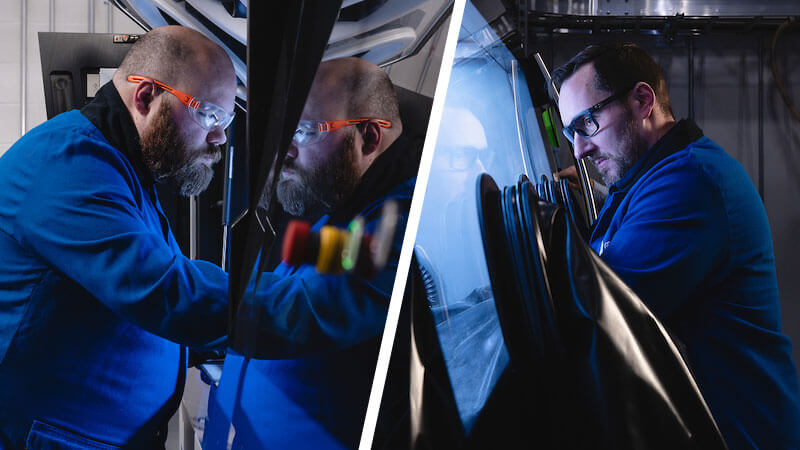
WEST LAFAYETTE, Ind. — Colibrium Additive, a GE Aerospace company, has embedded two full-time engineers into everyday operations at Purdue Applied Research Institute’s (PARI) Hypersonics Advanced Manufacturing Technology Center (HAMTC).
This arrangement, which leverages Colibrium Additive’s technical expertise with PARI’s innovative research portfolio, aims to provide a new framework for university-industry collaboration.
David Bretz, PARI’s senior project manager for this effort, said this on-site support from Colibrium Additive (formerly GE Additive) helps researchers to more efficiently produce novel hypersonic technologies that transition to the defense industry.
“These engineers from Colibrium Additive provide insights that move our research along further and more rapidly than if we had to reach out via email or collaborate virtually,” Bretz said. “We hope to create the model that other industry partners can replicate for other areas of expertise.”
HAMTC is the first center founded under PARI. It is the only hypersonics center in the nation with design, manufacturing, joining and testing capabilities.
“We established HAMTC with the very ambitious goal of creating a one-stop shop for industry partners to collaborate with our own researchers on hypersonic materials and manufacturing innovations,” said PARI President and CEO Mark Lewis. “Colibrium Additive has been a key player and valued partner in developing the facility, as they have supplied absolutely cutting-edge equipment to enable research on high-temperature materials and additive manufacturing processes.”
With that equipment came two Colibrium Additive employees, Nate Humbert and Ryan Saucier, who serve as the additive manufacturing subject matter experts at HAMTC. They support staff, faculty and students through all aspects of the additive manufacturing process.
“We’re project manager, design engineer, software simulation engineer, manufacturing engineer, operator and service engineer all combined into one role,” said Humbert, who earned a Master of Science in aeronautics and astronautics from Purdue. “We put on multiple hats to provide services and enable additive manufacturing capabilities at HAMTC.”
Humbert and Saucier possess PARI credentials, which means they are fully integrated into the university system. As such, their roles, officially lead additive manufacturing engineers, are multifaceted. They help to maintain everyday operations while supporting PARI researchers more holistically. For instance, they have helped shape the facility by discussing standard operating procedures, providing input on the layout of the equipment and reinforcing safety protocols.
“Because HAMTC as a facility is such a new concept, there is a knowledge gap,” Saucier said. “That’s why we’re here, to help fill those gaps and do our best to support the entire team using our background in additive manufacturing.”
A typical day for Humbert and Saucier can encompass the entire additive manufacturing process. They will check part designs using a computer modeling program that ensures the part will come out of the printer looking exactly as intended. Then they help facilitate and monitor the printing process. Finally, they’ll process the print by clearing the excess powder, cutting the part off the printing plate and applying a heat treatment to reduce the likelihood of deformation.
Two of the Colibrium Additive 3D printers housed at HAMTC are the M2 and X Line 2000. Both machines employ a laser that melts and fuses together particles to form a solid part. These printers are used for a variety of projects, such as the design of new high-temperature alloys for hypersonic systems and large-scale metal additive manufacturing. The latter includes a prototype of a full-scale, fully operational scramjet, an engine that enables hypersonic vehicles to reach speeds above Mach 5.
Ultimately, the PARI researchers’ goal is to tackle pressing national security challenges that can only be solved by a team with diverse skill sets.
“There are so many talented PARI researchers that have been brought together here at HAMTC. However, we’re only as strong as our weakest link, and our team lacked the additive manufacturing expertise required to perform applied research,” Bretz said. “Colibrium Additive brings a high level of technical expertise, motivation and desire to help solve problems. Their contribution makes the whole become stronger than its parts.”
Colibrium Additive merges “collaborative” and “equilibrium,” representing the company’s commitment to assisting customers in their additive manufacturing process and delivering reliable and scalable results. The name also underscores the company’s leadership in the additive industry by educating regulators, collaborating with academic institutions and fostering the next generation of talent.
About Purdue University
Purdue University is a public research institution demonstrating excellence at scale. Ranked among top 10 public universities and with two colleges in the top four in the United States, Purdue discovers and disseminates knowledge with a quality and at a scale second to none. More than 105,000 students study at Purdue across modalities and locations, including nearly 50,000 in person on the West Lafayette campus. Committed to affordability and accessibility, Purdue’s main campus has frozen tuition 13 years in a row. See how Purdue never stops in the persistent pursuit of the next giant leap — including its first comprehensive urban campus in Indianapolis, the new Mitchell E. Daniels, Jr. School of Business, Purdue Computes and the One Health initiative — at https://www.purdue.edu/president/strategic-initiatives.
Writer/Media contact: Lindsey Macdonald, macdonl@purdue.edu
Sources: Mark Lewis, marklewis@purdue.edu
David Bretz, dbretz@purdue.edu